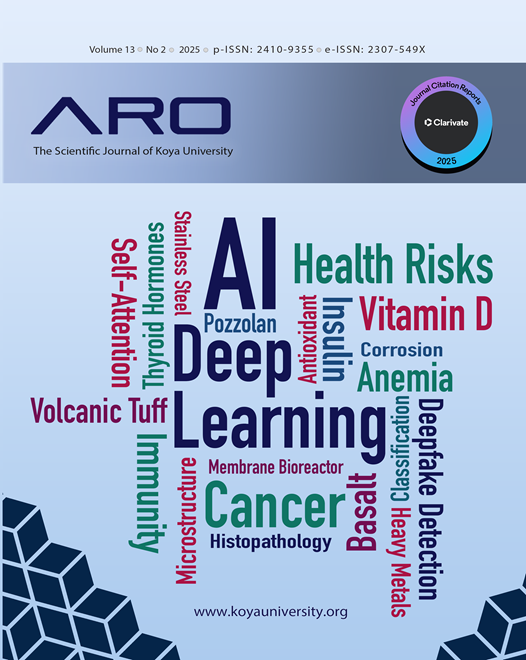Performance Evaluation of Membrane Bioreactor Operational Design in Sewage Treatment Plant using GPS-X Software
DOI:
https://doi.org/10.14500/aro.12033Keywords:
Characteristic of sewage, GPS-X modeling, Membrane bioreactor, Membrane filtration, Sewage treatment processesAbstract
This study evaluates the operational performance of a full-scale membrane bioreactor wastewater treatment plant located in Kuala Lumpur using GPS-X 8.0 simulation software. Key performance indicators–including mixed liquor suspended solids (MLSS), transmembrane pressure (TMP), dissolved oxygen, and effluent total suspended solids (TSS)were monitored over 30 days. The simulations were conducted using the advanced mode and calibrated with actual plant data. Results show that although the plant complies with Malaysian effluent discharge standards, it operates well below its design capacity, with MLSS levels significantly lower than recommended. This operational underload contributes to increased energy consumption and reduced treatment efficiency, particularly in terms of TSS and chemical oxygen demand removal.
Downloads
References
Abbasi, N., Ahmadi, M., and Naseri, M., 2021. Quality and cost analysis of a wastewater treatment plant using GPS-X and Cabinetwork simulation programs. Journal of Environmental Management, 284, p.111993. DOI: https://doi.org/10.1016/j.jenvman.2021.111993
Al-Sayed, A., Hellal, M.S., Al-Shemy, M.T., and Hassan, G.K., 2023. Performance evaluation of submerged membrane bioreactor for municipal wastewater treatment: Experimental study and model validation with GPS-X software simulator. Water and Environment Journal, 37(1), p.480-492. DOI: https://doi.org/10.1111/wej.12852
American Public Health Association (APHA), 2012. Standard Methods for the Examination of Water and Wastewater. 22nd ed. APHA, Washington, DC.
Barreto, D.P., Alzate Marin, J.C., and Judd, S.J., 2017. Membrane bioreactors for wastewater treatment. Water Research, 114, pp.172-183.
Bencheikh, I., Mabrouki, J., Azoulay, K., Moufti, A., and El Hajjaji, S., 2020. Predictive analytics and optimization of wastewater treatment efficiency using statistic approach. In: Big Data and Networks Technologies. Vol. 3. Springer International Publishing, Cham, pp.310-319 DOI: https://doi.org/10.1007/978-3-030-23672-4_22
Dawood, A.S., 2022. Performance Analysis of Membrane Bioreactor Operational Design in Sewage Treatment Plant using GPS-X Software. [MSc thesis]. Universiti Sains Malaysia, School of Civil Engineering.
Fattah, G., Elouardi, M., Benchrifa, M., Ghrissi, F., and Mabrouki, J., 2023. Modeling of the coagulation system for treatment of real water rejects. In: Advanced Technology for Smart Environment and Energy. Springer International Publishing, Cham, pp.161-171. DOI: https://doi.org/10.1007/978-3-031-25662-2_14
Hydromantis, 2020. GPS-X Technical Manual (Version 8.0). Ch. 4. Creating an MBR Model Using GPS-X Software. Available from: https://hydromantis.com
Jasim, N.A., and Aziz, H.A., 2020. The design of wastewater treatment plant (WWTP) with GPSX modelling. Cogent Engineering, 7(1), p.1723782. DOI: https://doi.org/10.1080/23311916.2020.1723782
Judd, S., 2010. The MBR Book: Principles and Applications of Membrane Bioreactors in Water and Wastewater Treatment. 2nd ed. Elsevier, Amsterdam.
Kitagawa, T., Matsushita, T., and Hara, M., 2012. Performance evaluation of an MBR system for advanced wastewater treatment. Water Science and Technology, 65(5), pp.906-912.
Krzeminski, P., Iglesias, R.L., and Van der Graaf, J.H.J.M., 2017. Membrane fouling in MBRs: Occurrence, prevention, and control. Journal of Membrane Science, 527, pp.113-125.
Le, G.A., 2024. Modeling and Simulation of the Ammonia Process at Bekkelaget Wastewater Treatment Plant using GPS-X [Master’s thesis]. University of SouthEastern Norway, Norway.
Mabrouki, J., Benbouzid, M., Dhiba, D., and El Hajjaji, S., 2022. Simulation of wastewater treatment processes with Bioreactor Membrane Reactor (MBR) treatment versus conventional the adsorbent layer-based filtration system (LAFS). International Journal of Environmental Analytical Chemistry, 102(19), pp.7458-7468. DOI: https://doi.org/10.1080/03067319.2020.1828394
Medellín-Castillo, N.A., González-Martínez, Á., Barrios-Piña, H., Espinosa-Rodríguez, M.A., and González-Fernández, L.A., 2023. Modeling and simulation of an urban wastewater treatment plant with an anorexic-aerobic-MBR system using GPS-X software. Environmental Engineering and Management Journal, 22(11), pp.1767-1776. DOI: https://doi.org/10.30638/eemj.2023.166
Meng, F., Zhang, H., Yang, F., and Liu, L., 2017. Membrane fouling in membrane bioreactors: Characterization and mitigation. Water Research, 114, pp.20-30. DOI: https://doi.org/10.1016/j.watres.2017.02.006
Nemerow, N.L., 2010. Industrial Water Pollution: Origins, Characteristics, and Treatment. Addison-Wesley, Boston.
Phillips, S., Rathnayake, R., and Sewell, S., 2009. Application of GPS-X modeling software for wastewater treatment plant optimization. Environmental Modelling and Software, 24(6), pp.805-813.
Razak, R., 2010. Wastewater management in Malaysia: Progress and challenges. Environmental Science and Policy, 13(4), pp.334-339. DOI: https://doi.org/10.1016/j.envsci.2010.07.001
Schraa, O., Spanjers, H., and Van Lier, J.B., 2010. Modelling and optimization of wastewater treatment processes using BioWin. Water Science and Technology, 61(6), pp.1515-1522.
Serdarevic, A., Spanjers, H., and Van Lier, J., 2016. Advanced modeling techniques in MBR wastewater treatment. Water Science and Technology, 74(8), pp.1924-1932.
Smith, A.L., 2023. Modelling and optimization of wastewater treatment systems using GPS-X and BioWin. Environmental Modelling and Software, 158, p.105443. Yoon, S.H., 2015. Membrane Bioreactor Processes: Principles and Applications. CRC Press, United States.
Downloads
Published
How to Cite
Issue
Section
License
Copyright (c) 2025 Ali S. Dawood, Fatehah M. Omar, Amera G. Baker, Hawbash H. Karim

This work is licensed under a Creative Commons Attribution-NonCommercial-ShareAlike 4.0 International License.
Authors who choose to publish their work with Aro agree to the following terms:
-
Authors retain the copyright to their work and grant the journal the right of first publication. The work is simultaneously licensed under a Creative Commons Attribution License [CC BY-NC-SA 4.0]. This license allows others to share the work with an acknowledgement of the work's authorship and initial publication in this journal.
-
Authors have the freedom to enter into separate agreements for the non-exclusive distribution of the journal's published version of the work. This includes options such as posting it to an institutional repository or publishing it in a book, as long as proper acknowledgement is given to its initial publication in this journal.
-
Authors are encouraged to share and post their work online, including in institutional repositories or on their personal websites, both prior to and during the submission process. This practice can lead to productive exchanges and increase the visibility and citation of the published work.
By agreeing to these terms, authors acknowledge the importance of open access and the benefits it brings to the scholarly community.
Accepted 2025-07-13
Published 2025-08-25
















 ARO Journal is a scientific, peer-reviewed, periodical, and diamond OAJ that has no APC or ASC.
ARO Journal is a scientific, peer-reviewed, periodical, and diamond OAJ that has no APC or ASC.